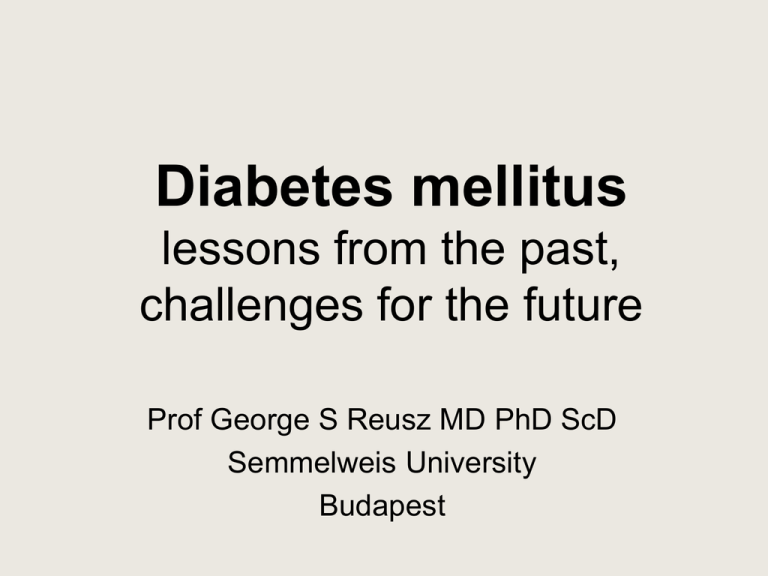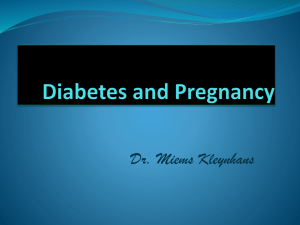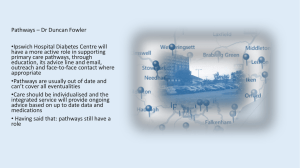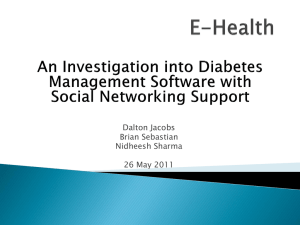
Diabetes mellitus
lessons from the past,
challenges for the future
Prof George S Reusz MD PhD ScD
Semmelweis University
Budapest
Diabetes
•
•
•
•
•
•
•
Definition
History
Classification
Comorbidities → Obesity, hypertension, dyslipidemia
Complications → Micro- and macrovascular disease
Treatment - challanges
Social consequences - Epidemiology
Diabetes
•
•
•
•
•
•
•
Definition
History
Classification
Comorbidities → Obesity, hypertension, dyslipidemia
Complications → Micro- and macrovascular disease
Treatment - challenges
Social consequencies - Epidemiology
What is diabetes?
• Diabetes is a group of heterogeneous
disorders with the common elements of
hyperglycaemia and glucose intolerance,
due to:
* insulin deficiency
* impaired
effectiveness of
insulin action
* or both
Diabetes
•
•
•
•
•
•
•
Definition
History
Classification
Comorbidities → Obesity, hypertension, dyslipidemia
Complications → Micro- and macrovascular disease
Treatment - challanges
Social consequencies - Epidemiology
Diabetes History
1550 BC: First Written Document:
Ebers papyrus lists several means ‘‘to drive
away the passing of too much urine.’’
250 BC: The Word Diabetes First Used
• Apollonius of Memphis coined the name
"diabetes” meaning "to go through" or siphon.
He understood that the disease drained more
fluid than a person could consume.
• Gradually the Latin word for honey, "mellitus,"
was added to diabetes because it made the
urine sweet
200 AD: Aretaeus the Cappadocian
Diabetes is a wonderful affection, not very frequent
among men, being a melting down of the flesh and
limbs into urine…The flow is incessant, as if from the
opening of aqueducts…it takes a long period to form,
but the patient is short-lived…for the melting is rapid,
the death speedy.
Moreover, life is disgusting and painful; thirst
unquenchable; excessive drinking…and one cannot
stop them either from drinking or making water... they
are affected with nausea, restlessness, and a burning
thirst; and at no distant term they expire.
Historical chronology of basic and clinical research in diabetic nephropathy and contributions of Japanese scientists Jun
Wada, Hirofumi Makino. Clin Exp Nephrol (2009) 13:405–414
Sixth century
Hindu healers wrote that flies and ants
were attracted to urine of people with a
mysterious disease that caused intense
thirst, enormous urine output, and wasting
away of the body
Early Research
• In 1798, John Rollo documented excess sugar in
the blood and urine
• In 1813, Claude Bernard linked diabetes to glycogen
metabolism
• In 1869, Paul Langerhans, a German medical
student, discovered islet cells in the pancreas
• In 1910, Sharpey-Shafer of Edinburgh suggested a
single chemical was missing from the pancreas. He
proposed calling this chemical "insulin."
• In Jan, 1922, Banting and Best
injected a 14-year-old patient with
newly developed pancreas extract
• It caused his blood glucose to fall from
520 to 120 mg/dL in 24 hours
• The patient lived a relatively healthy
life for 13 years before dying of
pneumonia at 27
C. H. Best and F. G. Banting ca. 1924
Impact Of Insulin On
Life Expectancy By The 1940’s
Age at start of
diabetes
50
30
10
Average age of
death in 1897
58.0
34.1
11.3
Average age of
death in 1945
65.9
60.5
45.0
Years Gained
8
26
34
Diabetes
•
•
•
•
•
•
•
Definition
History
Classification
Comorbidities → Obesity, hypertension, dyslipidemia
Complications → Micro- and macrovascular disease
Treatment - challenges
Social consequencies – Epidemiology
Diabetes = group of heterogeneous
disorders
• type 1 diabetes: insulin deficiency
• type 2 diabetes: impaired effectiveness
of insulin action with initially high insulin
levels > later insulin deficiency develops
(85-95% of all diabetes in high-income countries)
• gestational diabetes mellitus
• other specific types
Type 1 diabetes
(insulin-dependent, immune-mediated or juvenileonset diabetes)
• destruction of the insulin-producing cells of
the pancreas, typically due to an autoimmune
reaction
• beta cells of the pancreas therefore produce
little or no insulin
• reasons: genetic predisposition? viral
infection? autoimmune disease?
Type 1
Diabetes
Type 1 diabetes: virus
infection or autoimmune
disease?
D Fairweather, NR Rose.
Nature Immunology 3,
338-40 (2002)
Virus infection
Type 1 diabetes - symptoms
•
•
•
•
•
•
•
abnormal thirst and a dry mouth
frequent urination
extreme tiredness/lack of energy
constant hunger
sudden weight loss
slow-healing wounds
recurrent infections
• blurred vision
Pls refer to: Aretaeus the Cappadocian 200 AD
Type 2 diabetes
• insulin resistance and relative insulin
deficiency
• not dependent on exogenous insulin
(but may require insulin for control of
hyperglycaemia if this is not achieved with diet alone
or with oral hypoglycaemic agents)
• no specific early signs or symptoms
Antechamber: Impaired glucose
tolerance (IGT)
• asymptomatic condition defined by
elevated (though not diabetic) levels of
blood glucose after oral glucose challenge.
• IGT: high risk of progressing to type 2
diabetes
Possible factors in the development of
type 2 diabetes
•
•
•
•
•
Obesity, diet and
physical inactivity
Insulin resistance
Family history of diabetes
Less than optimum intrauterine
environment
• Ethnicity
• Increasing age
Diabetes
•
•
•
•
Definition
History
Classification
Comorbidities → Obesity, hypertension
dyslipidemia
• Complications → Micro- and macrovascular disease
• Treatment - challenges
• Social consequencies - Epidemiology
Obesity, insulin resistance,
type 2 diabetes
• Obesity is highly correlated with an
increased risk of developing glycemic
dysorders
Evolution of the incidence of
obesity among children between
1963 and 2004
1999–2000 National Health and Nutrition Examination Survey (NHANES)
BMI>95 PC
The Link from Insulin Resistance to Type 2
Diabetes and its complications
Insulin
resistance
Diabetes
Early Cardiovascular Disease
Macrovascular
Stroke
Coronary Heart Disease
Microvascular
Amputations
Blindness
Opara JU et al. South Med J. 1997;90:1162-1168. Redon J, et al. J Hypertens 2009
Renal Failure
Prevalence of type 2 diabetes
across Europe
UK
3.9%
1.7 million
SWE
7.3%
460,000
BEL
4.2%
315,000
NED
3.7%
432,000
FRA
6.2%
2.7 million
GER
10.2%
6.3 million
SPA
9.9%
3.0 million
ITA
6.6%
2.9 million
Prevalence data, 2003
Adapted from IDF E-Atlas. Available at www.Eatlas.idf.org. Accessed 9 March 2007.
The progressive nature of type 2 DM
Normal
Impaired
glucose
tolerance
Type 2
diabetes
Late type 2
diabetes
complications
Insulin
sensitive
Hyperglycaemia
Normal insulin
secretion
Insulin
resistance
Normoglycaemia
β-cell
exhaustion
Insulin resistance
Fasting plasma glucose
Insulin sensitivity
Insulin secretion
Adapted from Bailey CJ et al. Int J Clin Pract 2004; 58:867–876.
Groop LC. Diabetes Obes Metab 1999; 1 (Suppl. 1):S1–S7.
Diabetes
•
•
•
•
•
Definition
History
Classification
Comorbidities → Obesity, hypertension,dyslipidemia
Complications→ Micro- and macrovascular
disease
• Treatment - challenges
• Social consequencies - Epidemiology
The major diabetes complications
Eye
(retinopathy)
Brain and cerebral circulation
(cerebrovascular disease)
Heart and coronary circulation
(coronary heart disease)
Kidney
(nephropathy)
Periferial nervous system
(neuropathy)
Lower limbs
(peripherial vascular disease)
Diabetic foot
(ulceration and amputation)
IDF Diabetes Atlas, 4th ed. © International Diabetes Federation, 2009
Hypertension and diabetes increase the burden of
vascular disease and target organ damage
Atherosclerosis
Arterial stiffness
LVH
LARGE ARTERIES
BP, PP
CV risk
Remodeling of small arteries
Arteriolo-capillary rarefaction
MICROCIRCULATION
Tissue perfusion ↓
(kidney, heart, brain, retina)
Adapted from: Creager M et al. Circulation 2003
Diabetes increases risk of major cardiovascular
events and death in hypertensive patients
CV death
Major CV events
% 20
% 8
X 1.6
15
10
X 1.8
17.3
6
4
10.7
5
2
0
0
Without diabetes
N=107605
Diabetes
N=34148
BPLTT Collaboration. Arch Intern Med 2005;165:1410-19.
7.6
4.1
Without diabetes
N=107605
Diabetes
N=34148
Hypertension increases risk of macro and
microvascular disease in patients with diabetes
Microvascular disease
50
incidence per 1000 patients- years (%)
incidence per 1000 patients- years (%)
Myocardial infarction
40
30
20
10
0
113 125 135 144 154 169
mean SBP (mm Hg)
Adler A, et al. BMJ. 1998;321:412-419.
50
40
30
20
10
0
113 125 135 144 154 169
mean SBP (mm Hg)
The vicious circle of macro and microvascular
damage in hypertension and diabetes
Large
vessels
Increased wave
reflection
Large artery
stiffness
Capillary
rarefaction
Microcirculation
Increased SBP, PP
(central and
peripheral)
Adapted from: Pessina AC. J Hypertens. 2007; 25:S13-S18.
Microvascular
damage
Early vascular complicationsnon-invasive measurements
Pannier et al. Stiffness of Capacitive and Conduit Arteries
Prognostic Significance for End-Stage Renal Disease Patients Hypertension.
2005;45:592-596
Diabetic nephropathy
• A microvascular complication of diabetes
marked by albuminuria and a deteriorating
course from normal renal function to ESRD
• The leading cause of chronic renal disease in
patients starting renal replacement therapy
Diabetic Nephropathy
Renal replacement therapy (RRT)
Year 2000 percentages of incident RRTpatients with diabetes
as the primary diagnosis according to national registries
RRT in Patients with Diabetes and End-Stage Renal Disease Locatelli et al. J Am Soc Nephrol 15: S25–S29, 2004
Albuminuria 30 - 300 mg/day got called
“Microalbuminuria”
• it predicts the development of clinical nephropathy
• one “positive” is not enough in the low range
• detected by measuring the albumin/creatinine ratio
on a spot urine sample
Association of Microalbuminuria to
Blood Pressure
Essential
Hypertension
IDDM
Urinary Albumin Excretion
(mg/24 hours)
3000
300
30
3
0
80
100
120
140
160
180
200
Systolic Blood Pressure (mmHg)
Marre, Am J Hypertens, 1998; 11:884-886
220
Incidence of new cases of ESRD according to the severity of GFR
impairment and the presence or absence of a dipstick proteinuria
test in a 17-yr follow-up of a cohort of 95,252 patients
Gansevoort, R. T. et al. J Am Soc Nephrol 2009;20:465-468
Epidemiology
(Diabetic Nephropathy - DN)
• About 20-30% of patients with type I DM
develop microalbuminuria, less than half
progress to overt nephropathy
• 5-60% of type II DM patients develop DN,
depending on ethnicity
Diabetic nephropathy
epidemiology
• Risk factors:
– Hypertension
– Hyperglycemia
– Microalbuminuria
– Ethnicity
– Male gender
– Family history
– Cigarette smoking
Rel. art.: Predictive value of microalbuminuria in longstanding insulin dependent diabetes.
K Borch-Johnsen BMJ. 1993; 306: 271–2
Rel. art.: Predictive value of microalbuminuria in longstanding insulin dependent diabetes.
K Borch-Johnsen BMJ. 1993; 306: 271–2
Glomerular mesangial cells:
- concentrated toward the vascular pole of the glomerulus
- produce the mesangial matrix which contributes to the
maintenance of the filtration membrane
- High glucose and ANG II activate intracellular signaling
processes leading to mesangial cell proliferation
Glomerulus
Light micrograph of a typical glomerular lesion of diabetic
nephropathy.
E: Exudative lesion, N: nodular lesion (PAS)
Expansion of mesangial matrix
with diffuse and nodular
glomerulosclerosis
(Kimmelstiel-Wilson nodules)
Thickening of glomerular and
tubular BM
Arteriosclerosis and hyalinosis of
afferent and efferent arterioles
Tubulointerstitial fibrosis
Historical chronology of basic and clinical research in diabetic nephropathy and contributions of
Japanese scientists Jun Wada, Hirofumi Makino. Clin Exp Nephrol (2009) 13:405–414
Scanning electron micrograph of glomerular lesions in
diabetic nephropathy.
Mesangial matrix (MM) expansion and narrowing of capillary lumen
(CL) are seen. From the mesangial matrix, the layer of the matrix is
extended to the endothelial cell side of the capillary (arrowheads)
Historical chronology
of basic and clinical
research in diabetic
nephropathy and
contributions of
Japanese scientists
Jun Wada, Hirofumi
Makino. Clin Exp
Nephrol (2009)
13:405–414
Pathogenesis
(Diabetic Nephropathy)
• Genetic predisposition to or protection
from diabetic nephropathy
– Differences in prevalence of microalbuminuria,
ESRD in different patient populations
– Only half of patients with poor glycemic control
will develop diabetic nephropathy
– Family studies
• Multiple genes may be involved
Genetics
PPARγ, ADIPOQ, ADRB3
RBP4 (source)
Genetic predisposition
FABP2, GYS1, GCGR
IGF1 (and other tissue)
ENPP1, INSR, IRS1, IRS2,
PGC1, SIRT1
RBP4, PIK3R1, PPP1R3A,
FOXO1, FOXA2
Key:
NOS2 (endothelial cells)
ICF7L7
Kir6 x ABCC8
(hypothalamus)
Genes with some genetic or biological
evidence of association with diabetes
CAPN19, HHF4α, TCF1,
ABCC8, KCNL11,
SCL2A2 (GLUT2), UPC2,
IAPP, INS, SIRT1, ARNT,
FOXO1, NNT
Genes also associated with monogenic
diabetes
New candidate genes for testing
Genes in bold and underlined are the
best supported by human genetic data
Candidate genes - type 1 diabetic nephropathy
Diabetes
•
•
•
•
•
Definition
History
Classification
Comorbidities → Obesity, hypertension, dyslipidemia
Complications → Micro- and macrovascular disease
• Treatment - challenges
• Social consequencies- Epidemiology
Challenges in the Management of Diabetes
The ultimate goal of diabetes therapy
to prevent micro- and macrovascular
complications in order to improve life expectancy
and quality of life
Treatment
• Lifestyle modification
– Weight, physical activity, controlled salt
•
•
•
•
•
Glycemic control
Hypertension control
RAS blockade
Lipid control
Aspirin
• Dietary protein restriction
KDOQI Clinical Practice Guidelines and Clinical Practice
Recommendations for Diabetes and Chronic Kidney Disease, 2007
Treatment objectives at different stages of
the renal continuum
REGRESS
PREVENT
RETARD
Macroalbuminuria
Microalbuminuria
Adapted from Dzau VJ, et al. Circulation. 2006;114;2850-2870.
End-stage
renal
disease
The decline in GFR over years in relation
to urinary albumin excretion
Gansevoort, R. T. et al. J Am Soc Nephrol 2009;20:465-468
The Diabetes Control and Complications Trial
(DCCT) and United Kingdom Prospective
Diabetes Study (UKPDS):
lowering glycaemia (measured as HbA1c)
less microvascular complications in type 1 as
well as type 2 diabetes
DCCT: Diabetes Control and Complications Trial Research Group. The effect of
intensive diabetes treatment on the development and progression of long-term
Explanation
complications in insulin-dependent diabetes mellitus: the Diabetes Control and
glycaemic
metabolic
memory: level of glucose control
Complications Trial.
N Engl J Med,1993;329:978-986.
in the early years of disease impacts dramatically on
UKPDS: UK Prospective Diabetes Study Group. Intensive blood glucose control
the
development
of compared
later complications
with sulphonylureas
or insulin
with conventional treatment and risk of
complication in patients with type 2 diabetes. Lancet, 1998;352:837-853.
UKPDS: Correlation of HbA1c concentration with
rates of diabetic complications
Any diabetes-related endpoint
Adjusted incidence rate per
1,000 person–years (%)
160
140
120
100
80
60
40
20
0
5
6
7
8
9
Mean HbA1c concentration (%)
10
11
Error bars = 95% CI
Adjusted for age, sex and ethnic group; expressed for white males, aged 50–54 at
diagnosis, mean duration of diabetes of 10 years
Adapted from Stratton IM, et al. UKPDS 35. BMJ 2000; 321:405–412.
Proportion of patients with events during the
follow-up of UKPDS
3867 patients with diabetes
over 10 years.
(a) Conventional group
(haemoglobin A1c 7.9%);
intensive group (haemoglobin A1c 7%)
(b) Conventional group (154/87mmHg)
intensive group (144/82mmHg).
UK Prospective Diabetes Study Group. Tight blood pressure control and risk of
macrovascular and microvascular complications in type 2 diabetes: UKPDS 38.
BMJ 1998; 317:703–713.
Proportion of patients with events during the
follow-up of the CARD study
Lancet 2004; 364:685–696
Placebo vs atorvastatin
Collaborative Atorvastatin Diabetes
Study
2838 patients with diabetes with one or more other risk factor
(hypertension, retinopathy, albuminuria, smoking).
Treatment
(Diabetic Nephropathy)
• ACE inhibitors or ARB have a strong
antiproteinuric effect apart from their
antihypertensive actions
• Increasing the dose of the ACEI or ARB beyond
the optimum antihypertensive doses further
reduces proteinuria
• Antiproteinuric effect is enhanced by a low Na
diet or diuretic
• RAS blocade: ACE inhibitors:
– Type I diabetes with nephropathy:
Lewis et al. NEJM, 1993. captopril vs. placebo
Proportion of patients with diabetes with events
during the follow-up of the MICRO–HOPE study
Lancet 2000; 355:253–259.
ramipril
Heart Outcomes Prevention Evaluation
3577 patients with diabetes with a follow-up of more than 4.5 years (60% of patients had
coronary events). conventional group (142/79 mmHg); ramipril group (142/80mmHg)
Treatment
(Diabetic Nephropathy)
RAAS blockade
• Although ACE inhibitors and ARB attenuate the
progression to renal failure, they do not halt it.
• One limiting factor may be feedback effects of ACEis
and ARBs, such as increased plasma renin activity.
• Aliskiren is a newer agent that inhibits renin, the
rate-limiting step in the RAAS.
• Triple RAAS blockade?
ADVANCE provides evidence
for further BP reduction versus UKPDS
Lancet 2007;
370:829–840.
Perindopril
+
Indapamide
Action in Diabetes
and Vascular Disease
Vs conventional
N=11440 (!)
ADVANCE
UKPDS
SBP, mmHg
Treatment
(Diabetic Nephropathy)
• Hypertension control:
– Lower the BP, slower the decline in GFR in patients
with diabetic nephropathy
– JNC VI recommended BP < 130/85 mmHg in patients
with renal insufficiency
– Patients with CKD and > 1g proteinuria, BP goal
should be < 125-130/75-80 mmHg
*JNC: Joint National Committee on Prevention, Detection,
Evaluation, and Treatment of High Blood Pressure
Summary
Macrovascular and microvascular disease
• Major cause of early morbidity and mortality
• Agressive treatment of hypertension and
dyslipidemia
• Intensive treatment of modifiable risk factors
- Lifestyle: increase physical activity
- Improved diet: reduce total and saturated fat,
increase monosaturated fat, antioxidants and
flavonoids
International Diabetes Federation, 2008
Diabetes
•
•
•
•
•
•
Definition
History
Classification
Comorbidities → Obesity, hypertension, dyslipidemia
Complications → Micro- and macrovascular disease
Treatment - challenges
• Social consequencies- Epidemiology
Total world population
IDF Diabetes Atlas, 4th ed. © International Diabetes Federation, 2009
Prevalence (%) estimates of diabetes (20-79 years), 2010
IDF Diabetes Atlas, 4th ed. © International Diabetes Federation, 2009
Prevalence (%) estimates of diabetes (20-79 years), 2030
IDF Diabetes Atlas, 4th ed. © International Diabetes Federation, 2009
Summary of prevalence (%) ranges of diabetes complications
(all diabetes) found in different studies
IDF International Diabetes Federation
Deaths attributable to diabetes as percentage of all
deaths (20-79 years) by region, 2010
IDF Diabetes Atlas, 4th ed. © International Diabetes Federation, 2009
TAKE HOME MESSAGE
The diabetes epidemic is here and threatens to
overwhelm health systems if left unchecked
The majority of type 2 diabetes cases can be
prevented — prevention costs governments far less
than treating diabetes and its complications.
The non-preventable forms of diabetes can be treated.
Diagnosis, treatment, management and prevention of
diabetes and other non-communicable diseases
require integrated health systems, delivery of care
down to primary care level, and supportive policies
outside the health sector.








